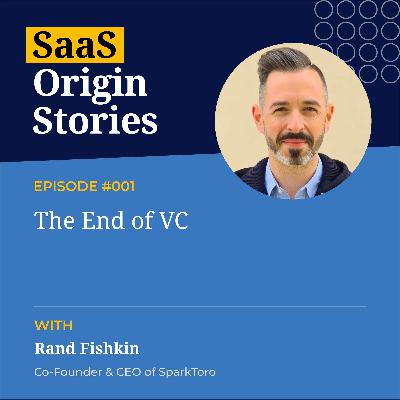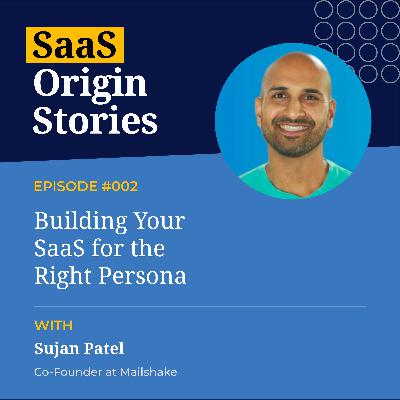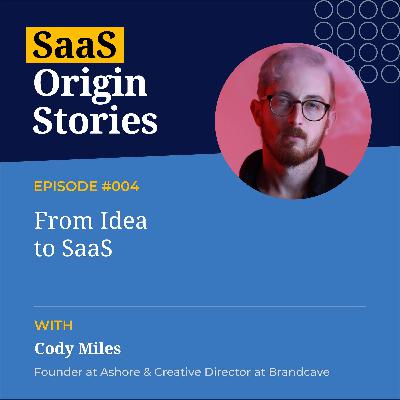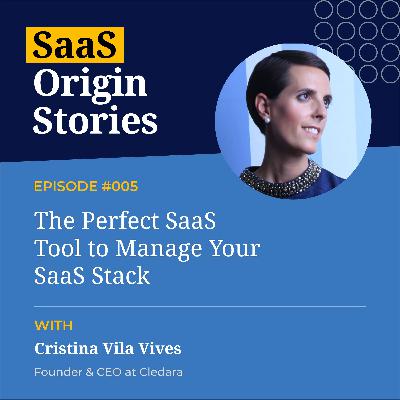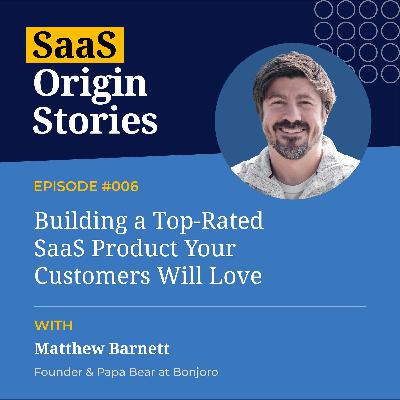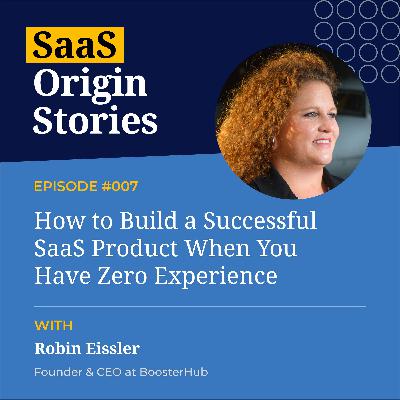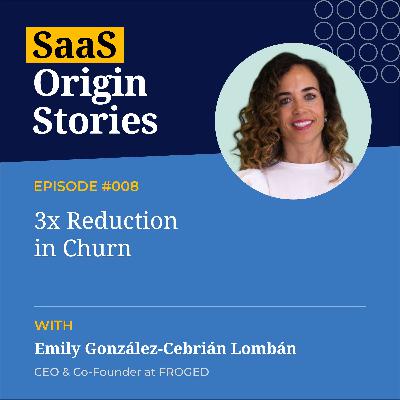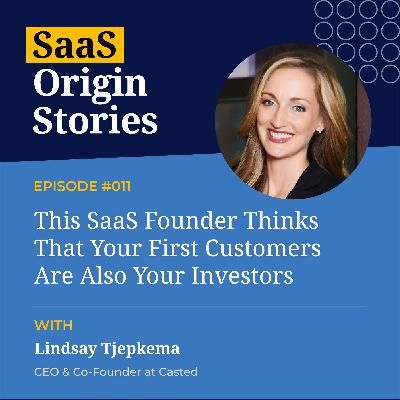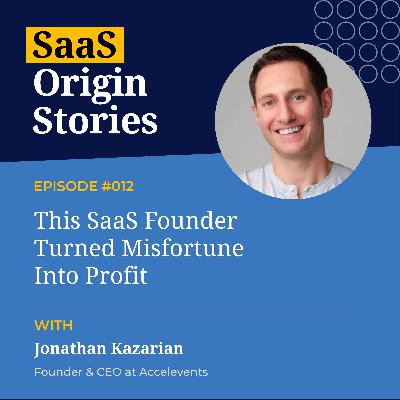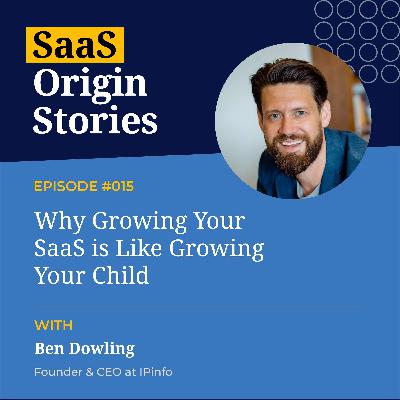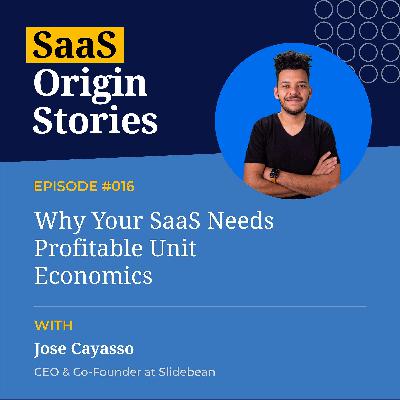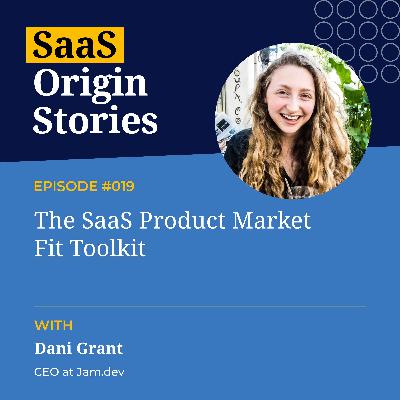Discover SaaS Origin Stories
SaaS Origin Stories

SaaS Origin Stories
Author: Phil Alves
Subscribed: 5Played: 47Subscribe
Share
© 2025 Phil Alves
Description
"Every SaaS hero has an origin story"
Join Phil Alves, host of SaaS Origin Stories, as he unravels deep conversations with founders as they share how they started their SaaS. You’ll hear first-hand dos and don’ts of building and growing a SaaS as well as inspirational stories to fuel you on your own journey into the world of SaaS.
Join Phil Alves, host of SaaS Origin Stories, as he unravels deep conversations with founders as they share how they started their SaaS. You’ll hear first-hand dos and don’ts of building and growing a SaaS as well as inspirational stories to fuel you on your own journey into the world of SaaS.
51 Episodes
Reverse
Behind every great SaaS company is an even greater story. More specifically, there is a great origin story.Salesforce. Slack. Shopify …All started with an idea, some code, and a lot of grit, determination and focus. Welcome to Saas Origin Stories.We host authentic conversations with founders as they share how they started their SaaS. We’ll cover painful challenges, early wins, and actionable takeaways. You’ll hear first-hand the dos and don’ts of building and growing a SaaS as well as inspirational stories to fuel you on your own SaaS journey.
How do you feel about the “succeed on a massive scale or die trying” model? Other unconventional routes to building businesses, including independent funding, crowdfunding, and bootstrapping, are now better alternatives. If you've ever thought about building a profitable company instead of raising cash, stay put… this episode is for you.Today we are joined by Rand Fishkin, co-founder and CEO of SparkToro, former CEO and Founder of Moz, and Author of Lost and Founder. He shares practical advice on how to build a non-venture backed company that is long-term profitable using the lessons he has learned from his experience as the founder of several companies.In this episode, we discuss:How Rand raised funds for SparkToro (HINT: no VC was involved)How SparkToro is different from MozWhat to prioritize for long-term business survivalThe role of audience research for sustainable growthInstructions on how to rate and review SaaS Origin Stories on Apple Podcasts can be found here.
The best SaaS businesses starts with trying to solve a problem for a specific customer persona. Though your product might be good, it might not fit the the ideal customer persona right. So what can you do about it?Listen to this episode of course…Sujan Patel, Co-Founder of Mailshake, joins the conversation to discuss his experience and mistakes building and growing Mailshake and how to identify product market fit.Sujan is a data-driven content marketer and entrepreneur. He is also the Managing Director at Ramp Ventures, a part-time Board Member of the Entrepreneurs' Organization, and the GM and Co-Founder of Web Profits.In this episode, we discuss:How to find the right customerBuilding and growing MailshakeHow Mailshake helps sales reps?How Sujan learns from his mistakes
The best SaaS businesses starts with trying to solve a problem for a specific customer persona. Though your product might be good, it might not fit the the ideal customer persona right. So what can you do about it?Listen to this episode of course…Starting a SaaS is hard.Starting a SaaS is harder when both co-founders have full-time jobs.Bryan Clayton, CEO and Co-founder of GreenPal, joins the conversation to discuss how they turned a household errand into an incredibly successful SaaS business... whilst two of the co-founders were working full-time.In this episode, we discuss:How GreenPal got their first customers by handing out flyersWhy software is never completeTreating your SaaS like a brick houseBuilding versus outsourcingProject versus task level thinking
How do you think collaboration can take place smoothly such that the creatives don't get bogged down in meetings or do things counterproductive to their skills because clients are tough to access and provide extremely poor feedback? Discover the innovative strategy used by a marketer and a creative to resolve this issue.Today we have Cody Miles, Founder at Ashore and Creative Director at Brandcave. Join us as we look back on his journey from idea to a ground-breaking company that offers thousands of creatives an environment to work out an effective way to connect with their clients. Cody Miles is an Austin, TX-based entrepreneur and UX designer. After years of struggling to collaborate with his clients, Cody founded Ashore, an online proofing software for high-velocity creatives. Today, Cody utilizes his background to run both Ashore and his digital marketing agency, Brandcave.In this episode, we discuss:The two main problems of creative peopleDealing with non-creative peopleWhat made Cody become an SaaS entrepreneurDealing with employee attrition as a founder of a creative agency
Companies use various SaaS products to manage and grow their businesses. But how do they keep track of these software applications? Cristina Vila Vives found that most either use spreadsheets ineffectively or do not manage them at all.Are there other alternatives? Passionate about bringing a solution, Cristina presents you with the Cledara platform, designed to improve SaaS stack management.In this episode, we discuss:Using Cledara to make better business decisionsFundraising tips that will help you succeedWhy should you first launch a Minimum Viable Product (MVP) to marketWhat should SaaS founders focus on when building a productHow to Nail Your Next FundraisingUnderstand what you want to build in the future and your product vision. Have a clear roadmap on what you want to do with the capital. Prepare well for every investor meeting and explain how you will achieve that vision.I remember that for every half-hour investor meeting, I would spend three hours preparing for all the possible questions they may ask - Cristina Vila VivesUse the Capital WiseAfter raising your first capital, think of launching the MVP to market. Find the right people to help you build the product and talk to potential customers to understand how they would like it to work. If you lack some business skills, bring a co-founder who can complement your weaknesses, someone strong in the go-to-market and business partnership operations. Then hire the first team members.Make sure that on that first version, you are building something people actually want - Cristina Vila VivesPeople Want Your Product...Help Them Realize ThatFinding the right product-market fit is a matter of building a SaaS product that helps your customers solve their problems. Your job is to understand them, develop your product according to their feedback, and help them realize the potential of your solution. You need these people who believe in your vision and are willing to dedicate their time to help you shape your ideas.When I started, I knew that it was just a matter of educating the market and building a product that would truly help companies when companies were ready to recognize that they had that problem - Cristina Vila VivesFor more interviews from the SaaS Origin Stories podcast, check us out on Apple, Spotify or your favorite podcast player!
Building great products starts with a strong desire to solve a problem you have encountered in your own experience. But there is more to it than that; you have to think about what makes it different, the value it brings to people, your brand's messaging, and much more.Matthew Barnett knows what it takes to build SaaS products that thrive. Matthew is the Founder and Papa Bear of Bonjoro, and today, he shares what SaaS founders need to do to develop products that people will love and help them grow successful businesses.In this episode, we discuss:Why are industry experts more likely to build successful startups?Biggest fears and challenges startup founders experienceHow can you drive customer loyalty?How should founders approach brand building?The Right Founder for the Right ProductIndustry experts are more likely to succeed when building a business. They are the ones who experience and understand industry problems, thus developing products that solve them is much easier.I think a lot of the most successful startups you see come from people who have a problem in a specific industry - Matt BarnettPrioritize Your Growth StrategyFrom day one, think about your specific growth mechanism, which depends on your company. Every business is different. Some are sales-driven, marketing-led, or ads-led. What works for one company doesn't mean it will work for you. I think it's extremely important…you have a mechanism that can do that - Matt BarnettHow Can You Drive Customer Loyalty?When people mention loyalty, they think about loyalty cards, discounts, and other benefits. However, loyalty is the ability to increase the lifetime value of your customers and generate advocacy, which leads to net new customers.If you nail loyalty, you increase the lifetime value of every customer. So every customer spends more and stays longer, and then you increase that by basing your customers as its growth channel - Matt BarnettYour Brand is More Than the LogoMany founders don't understand what a brand represents. Most just think about the logo and stop there. Besides visual elements, a brand is also how you talk to customers, what you stand for, your views, values, and people.A brand is basically like the external facing piece of your culture - Matt BarnettFor more interviews from the SaaS Origin Stories podcast, check us out on Apple, Spotify or your favorite podcast player!
You don't have any technical background, and you have no idea where or how to start building your SaaS product. But there is a problem you want to solve. Should you take on the challenge or leave it for someone else to deal with?This is the exact problem Robin Eissler, the Founder and CEO of BoosterHub faced. When Robin began her SaaS journey, she knew nothing about what developing software products involved. In this episode of SaaS Origin Stories, Robin shares what you need to start building your SaaS product when you have no experience, how to find the right people and mentors to help you, and how to drive a product-led growth strategy that will boost your sales.In this episode, we discuss:How does BoosterHub enhance booster clubsWhat is a booster clubBuilding a SaaS product with zero experienceHow to transition from sales-led to product-led growthBoosting the Nonprofit SpaceBoosterHub provides infrastructure for nonprofit organizations, specifically high school booster clubs, for their athletic and fine arts programs. It also enables volunteers to jump into the organization and have a ready-made set of tools that help them communicate, manage volunteers and fundraise.BoosterHub popped into my head like Hey, we need to use one tool to do all of this. And I was at a time in my life when it was time to start a new venture. So we decided to jump in and do it - Robin EisslerBuilding a SaaS Product With Zero ExperienceBefore starting BoosterHub, Robin worked in aviation and was also the Founder and President of Sky Hope Network. She says that running a new business is all about duplicating and adapting the systems and processes of the previous one. If you didn't have to deal with SaaS before, like Robin, a great idea is to find a mentor that will guide you. Also, spend some time learning basic SaaS principles and tools to get started.Running a business is really all about systems and processes and then duplicating those systems and processes - Robin EisslerFrom Sales-Led to Product-Led GrowthThe first BoosterHub customers were beta testers. The team adopted a classic SAS marketing strategy of building the funnel, prospecting, looking for contact information, working through the process of nurturing those leads, and selling them. In the beginning, you can start too with a sales-led approach, where you try to find the right people and present your product. As the product develops, you can take on a product-led approach.We're definitely trying to move to as much product-led as we can. I think the nature of our business will always remain some percentage of sales led just because of how booster clubs operate and the relationship model there - Robin EisslerFor more interviews from the SaaS Origin Stories podcast, check us out on Apple, Spotify or your favorite podcast player!
One of the most difficult challenges in building a SaaS product is understanding your user and putting yourself in their shoes. But when you are at the same time the user and the developer, the final result might become a hit.Let's see what that looks like in real life. For that, we invited Emily González-Cebrián Lombán, Co-founder and CEO of Froged, to share her story behind building a SaaS product that helps other SaaS subscription businesses succeed.In this episode, we discuss:How does Froged help SaaS businesses solve conversion and churn problems?How can SaaS businesses manage churn?Why should you constantly look for feedback as you develop your SaaS product?What does human power technology mean?A Problem-Solver for Subscription-Based SaaS BusinessesFroged is a SaaS product that focuses on customer success and support. The platform solves two main problems. One is converting users from free trials to paying customers, and the second is reducing the churn rate.The economy, in general, has been transformed into a subscription economy. So we are driving super fast towards this subscription economy where all businesses become platforms where they deliver subscriptions - Emily González-Cebrián LombánLaunching, Testing, and Getting FeedbackWhen launching the MVP, Emily and her team wanted to test and receive honest feedback from the market on every functionality they were developing. One way to do that is to launch your product in AppSumo, which can also help you find the product market fit.Whenever you create something like your baby and your own self. And you have to make sure that you don't attach yourself to that idea or to that project so that you're able to receive feedback - Emily González-Cebrián LombánManaging the ChurnChurn is one of the metrics that show how long your business can last. A subscription-based business grows by attracting new clients but also helping the clients you already have grow with you. A high churn rate indicates that you are losing money fast and not delivering what the market expects from you.You don't need to fight against churn, but to work proactively not to have it - Emily González-Cebrián LombánPowering PeoplePeople are the most valuable asset you have in your SaaS company. As your business develops, people realize things that allow them to have the lifestyle they want and be surrounded by the desired environment. Address these areas to maintain a positive culture and work environment people will love being a part of. We always say that we are a human power technology - Emily González-Cebrián LombánFor more interviews from the SaaS Origin Stories podcast, check us out on Apple, Spotify, or your favorite podcast player!
The demand for a killer digital experience is higher than ever. But when launching a new product, you don't have the luxury of time to see if you’ve made the right choices regarding its design. You must know what your customers want for from the very beginning. Fortunately, one piece of software allows you to get accurate user insights and create digital experiences people will adore: UserZoom. Today, one of its Co-founders and CVO, Alfonso de la Nuez, joins us to discuss:Alfonso's experiences that other entrepreneurs should add to their playbookHow UserZoom helps you deliver a best-in-class digital experienceWhat makes a great user experienceGetting User Insights for a Better Digital ExperienceUserZoom is a SaaS platform that helps businesses understand their end users by testing and measuring their behavior and the quality of experience with digital products. Thus, it gives you a better chance to create a great digital experience that will impact your business results positively.Fall in love with the problem before you launch your business - Alfonso de la NuezWhat Makes a Great User Experience?Retention is everything for a SaaS business. When you look at it in today's world, the end users purchase the software. So you have to build a phenomenal onboarding experience. A great UX design understands clearly what the end user looks for and even exceeds expectations by providing them guidance, convenience, and ease of use. When you deliver a great user experience, your customer will become your best salesperson and marketer.You only have one chance to provide a great first experience - Alfonso de la NuezThe Difference Between a VC and Private EquityPrivate equity typically likes to own a majority, put together their operating experience and capital, and grow with profitable companies. VCs tend to like minority investments and high, faster growth and a little more risk. VCs are not that active now, while private equity tends to be very active - Alfonso de la NuezFor more interviews from the SaaS Origin Stories podcast, check us out on Apple, Spotify or your favorite podcast player!
Most B2B SaaS founders start their businesses with the desire to solve some problems. Great products come from those who have experienced these problems themselves. And many opportunities arise from unexpected places or situations. That is how Vishal Sunak and his business partner, Chris Combs, came up with the idea of LinkSquares, an AI-powered contract management platform for legal teams. Their experience should become a playbook for SaaS entrepreneurs, and Vishal shares every step of their journey.In this episode, we discuss:How does AI make an impact in the SaaS space?Why should you do proper market research before building your SaaS product?How to choose the right technologyHow to market your SaaS productResearch Before BuildingBuilding a SaaS product might be exciting, especially if you're a builder. But many start creating their products too quickly. Then they are afraid to show the product to anybody because they don't know if they are creating something people want. Before building the product, ensure you're solving a problem multiple people face and would like to use your solution.We will not build the software until we talk to 100 general counsels and ensure we make the customer discovery, which is important in understanding the problem we're solving - Vishal SunakDon't Overthink the TechnologyWhen you start a SaaS company, you have to decide if it will be product-led, technology-led, or sales-led. If you decide on the product-led, find the technology that will allow you to focus on the product and not on the technology. One mistake many founders make is that they want to build their product and look for the most complex technology. Instead, use a stack framework platform that allows you to launch your product to market, like Ruby on Rails.I didn't want to pick any weird MEAN or LAMP stack, like a flash-in-the-pan technology in which only sixteen people on earth are experts. But how do we make it easy to hire people who know how to code in Rails, React front ends, and PostgreSQL back ends, like standard stuff? Not get obsessed with technology - Vishal SunakMake it Look Expensive.Your product should look and feel modern so that customers would pay the full price. Deliver that modern experience by getting a top UX designer to make your product look great, investing in your branding, delivering trendy features, and thinking about high-level usability.Make it look expensive, so your sales team can sell it at a decent price. If it looks like a 1990s Toyota Corolla with rust on the bumper, it will get priced like a 1990 Toyota Corolla with rust on the bumper. If it looks like a Rolls Royce phantom, that's the answer - Vishal SunakFor more interviews from the SaaS Origin Stories podcast, check us out on Apple, Spotify, or your favorite podcast player!
Creative content is the top ingredient when it comes to marketing. Things like podcasting could bring tons of value to your customers and business. But the challenge is to measure that value and show it in numbers. And Lindsay Tjepkema encountered the same problem. So she decided to build Casted. Today, she joins the SaaS Origin Stories podcast to share her journey in detail.In this episode, we discuss:What does amplified marketing mean?How can you understand if you are the right founder for a specific SaaS product?Why should you first develop and launch a Minimum Viable Product (MVP)?How does a strong network help you grow your customer base?Risk or RegretMany ideas remain theories because most people are too scared to act and see the outcomes. The uncertainty is too great. But one way to think about opportunities is to imagine if you will be more frustrated and disappointed if you do it and fail or if you never do it. If it's the second one, you should give it a shot. Otherwise, the regret of never trying could become unbearable.I already knew it was a good idea. And I couldn't bear the thought of somebody else doing it instead of me seeing this company come to life and see what it does, whether it was successful or a failure - Lindsay TjepkemaAre You the Right Founder?Starting a SaaS product and business is not a walk in the park. It is one of the most challenging and demanding activities someone could do. You must have strong incentives and a passion for the problem you are trying to solve and the product you build. Also, you should be a real industry expert who knows the market inside out and understands the customers well. Moreover, you must have a clear vision of what your solution looks like and how you can develop it.I am weirdly passionate about this problem we're solving, the company we're building, and this solution we've created - Lindsay TjepkemaLess is MoreVince Lombardi said: "Perfection is not attainable, but if we chase perfection, we can catch excellence." That applies to everything, including your SaaS product. When you first build and want to get it on the market, start with the bare minimum of capabilities. If things go well, develop your product, add features step-by-step, and focus on delivering value for your customers.We just quickly asked a bunch of questions to get to the root of what is the fastest thing we could build that would add the most value people would pay for. And how can we have a solid roadmap from there to keep people excited about what's coming next? - Lindsay TjepkemaBuild a Strong NetworkYour first ten customers are also the first investors you have to buy into your vision. If you succeed with that, the next phase is reaching one hundred customers by building a network and talking to people about your product. Keep in mind that your product should help them solve a problem or cover a need. So don't just try to sell to them. Listen to them, understand if you can help them, and treat them as human beings and individuals rather than customers.Customers come to my network, their networks, and then their networks. Be bullish and bold enough to ask for more conversations and introductions. I think you have to be approachable, and if you say that you're not gonna try to sell something, don't lie. Don't try to sell something - Lindsay TjepkemaFor more interviews from the SaaS Origin Stories podcast, check us out on Apple, Spotify, or your favorite podcast player!
Every SaaS product aims to solve one specific problem its founder encountered. But some products become all-round solutions to multiple problems in their category or niche. In the world of events, that is Accelevents. Today, its Founder and CEO, Jonathan Kazarian, shares his SaaS journey.In this episode, we discuss:How events impact your B2B marketing strategyGrowing numbers during an economic crisisHow to set up your SaaS product for endless growthInvesting more in customer experience rather than marketingHow Can Events Impact Your B2B Marketing Strategy?Delivering a better customer experience starts by gathering and analyzing data. Traditional marketing techniques for capturing that first-party data limit marketers in the level of information they can get. But events offer you the possibility of getting multiple touchpoints with your customers. People are more likely to share their data and help marketers leverage their efforts.Technology needs to be there to make life easier for event organizers - Jonathan KazarianFrom Zero to Hero and BeyondThough managing events is stressful, it can help companies bring in more data, customers, and revenue. However, during the pandemic crisis, many layoffs occurred, and companies were firing people responsible for organizing events. For Accelevents, the pandemic meant both the moment the business hit bottom rock, as it went down to zero in revenue and the beginning of constant growth. Jonathan and his team have been focusing on helping their clients and making them realize why events are significant for their businesses.In the world of events, you spend three months building this experience that culminates in three hours. You don't have even ten minutes to wait for a response - Jonathan KazarianA Golden SaaS StrategyIn terms of sales, for some brands, the final step is selling their products. For Accelevents, this is only an intermediate process. The company invests heavily in customer experience and focuses on helping their customers learn their platform and constantly engage to get their feedback and improve. So we made the decision that we want to invest in customer experience, and we won't invest in any mechanism of growth that will lead to a decrease in customer experience - Jonathan KazarianFor more interviews from the SaaS Origin Stories podcast, check us out on Apple, Spotify, or your favorite podcast player!
You found a problem and came up with an idea of how to solve it. All you have to do now is make it a reality. To do that you need a great plan to launch your business, get money, find your product-market fit, and so on. And one of the best ways to do that is by taking examples from successful SaaS founders, like John Stojka, the Co-Founder of Sertifi.In this episode, we discuss:Bootstrapping versus raising capitalHorizontal versus vertical marketsHow to find your vertical marketFinalizing Business FasterSertifi provides an agreement platform that brings contracts and payments together. Historically, people would send the contract, get it signed, and then request the payment. The platform combines those things into one process and builds a workflow around that. The idea for Sertifi came to John and Nick when they noticed that the contracts were getting lost and the contract execution component was time-consuming.We thought that the most important thing was to make sure that the contract signing and the payment processes were easy - John StojkaBootstrapping Versus Funding a SaaS BusinessIf you raise too much money too quickly, the risk of you not having a great outcome can be higher, and there is also time pressure that comes from the investors. When investors give you money, they expect you to either become a huge success or die. When bootstrapping, you move at your own pace, and the chances of your business growing are much higher. But, if you don't invest enough, and you don't get the capital that you need, you could miss the market too, and someone else will fill the gap.If you can get product market fit and some acceleration, I think you're pretty likely to get a base hit or a double, maybe even a triple. But if you're gonna raise a lot of capital, you will be gunning for that Grand Slam - John StojkaFinding Your VerticalIf you build a product and choose a vertical market, you can expand to other verticals. Besides, in a vertical market, it may be an easier customer solution. A horizontal market is more challenging and competitive and requires more money to succeed. The challenge is to find your vertical. The best way to do that is by asking the following questions: Has this market adopted any tool like this yet? Is there a standard CRM or a place of integration I can integrate into? Is there a need for this product?You pick a small pond, and you dominate it. We had this product that could solve various problems for many different people. But we didn't start getting success until about 2015 when we verticalized the solution for a specific vertical - John StojkaFor more interviews from the SaaS Origin Stories podcast, check us out on Apple, Spotify, or your favorite podcast player!
Every business has its golden formula for growth that works for them. But one SaaS platform might push things further by growing your brand awareness and referrals through word of mouth. That is Referral Rock, and today, its Founder and CEO, Josh Ho, shares in detail its origin story.In this episode, we discuss:How to make word-of-mouth referrals a part of your business growth strategyB2B versus B2C SaaS productsWinning strategies to build your team and scale your SaaS businessB2B Versus B2C SaaS ProductsThough B2B SaaS products are more complex, it's easier to sell and scale as you need fewer customers willing to spend more for a great product. For B2C, you need thousands of customers, and even if the market seems larger, it is much more difficult to sustain and develop from scaling and building infrastructure perspectives. But B2C seems more appealing to first-time entrepreneurs as they often want to deliver some value to the masses.I think people default to B2C because many are consumers first, and they want their friends and family to think it's cool. On the B2B side, you can find a small number of people, give them a huge value metric, and they don't really blink an eye at spending hundreds of dollars on software - Josh HoTake Notes of This Hiring StrategyBuilding and scaling a SaaS business implies strategically hiring the right people for specific positions. For Josh, that means learning enough first about a role and then hiring a mid-level specialist whom he can train to take on management responsibilities and build a team. And that person will also make the playbook, put it into an operation manual, learn it themselves, and then train other people.I modeled in my head as I would nail the job, and then I would scale up by finding other people and training them behind me - Josh HoLearn This Before Starting Your CompanyWhen you start being successful as an entrepreneur, you might feel mature enough to take on new challenges or that you're better than you are. But when you get to a new level, you might realize that you were not mature enough and there is still a lot you should learn. Be aware of this and constantly look for areas to improve before taking on new commitments.There was a lot more meat down in level two versus me trying to jump to level three or jump to level four - Josh HoFor more interviews from the SaaS Origin Stories podcast, check us out on Apple, Spotify, or your favorite podcast player!
What makes great SaaS companies thrive? Every business has its own story. But there’s one thing they all share, and that is a passionate founder who wants to solve a problem or cover a need. That is the case for Ben Dowling of IPinfo, who shares his company journey with the audience.In this episode, we discuss:How can IP data help your business?Building a business where you love to work Bootstrapping versus fundingAn effective hiring strategyHow to approach sales in SaaSHow Can IP Data Help You?IP data has plenty of uses, from website personalization to customizing website language, and currency and in cybersecurity, attacks on your network. Effectively, IP data also helps you gather more information and make more cost-effective decisions, deliver a better customer experience, and improve business advertising.We focus as a company on making sure our data's great and then leaving how customers want to use it to them. And there are a bunch of different use cases that it's useful for - Ben DowlingTake Your TimeSo many entrepreneurs try to move too quickly when building their businesses. Instead, try growing your company little by little, to the point where it makes enough money to support you. That allows you to create an enduring business where you love to work and don't need to rely on investors and instead can keep bootstrapping that company.I wanted to create something that I wanted to work on, a company where I wanted to work, the environment that I wanted to work in, and I was in no rush to see how big we can make it in a couple of years - Ben DowlingBootstrapping Versus FundingRaising money gives you a bunch of resources you can use. Funding can also be critical in some industries where you have well-funded competitors. However, bootstrapping allows you to grow your business slowly, experiment with different opportunities, and explore the problem you’re trying to solve.The nice thing with going at the pace that we're going at, which is quick for a bootstrap business, is that you get to identify opportunities as you go along. You incrementally build out what you're working on, and you have more time to explore the problem - Ben DowlingFor more interviews from the SaaS Origin Stories podcast, check us out on Apple, Spotify, or your favorite podcast player!
All founders dream that their business will skyrocket and succeed from the very beginning, but the reality is that most will fail. However, this isn’t a reason to give up. When you bounce back and start again, the story can repeat itself unless you learn the lessons of your failure. That was exactly the case for Jose Cayasso of Slidebean, who shares his insights and learnings from re-starting a SaaS business after failing the first time..In this episode, we discuss:The right moment to start a businessSolving problems for other SaaS entrepreneursWhy SaaS founders should focus on what they are good atHow to develop an effective customer acquisition strategyThe Right Moment to Start a BusinessBefore Slidebean, Jose left college and founded a startup that failed, which was when he started Slidebean. However, Jose believes that starting another company immediately after you fail is a bad idea because you focus on generating revenue quickly rather than following your business interests. For him, the best time to start a new business is once you’re an expert in an industry and discover a problem or opportunity. Then you can work on your company from a position of comfort rather than risking everything you have.I think the best companies get started when you have a job and discover something in the market that you have unique insight and expertise to solve. But you can do that from a position you can question this concept, whether it's a good or a bad idea - Jose CayassoLet Your First Product Do Its JobThe original version of Slidebean was simple, yet it served its purpose well. That’s a great strategy for building the first version of your product, in that it solves a specific problem for your customers. After that, you can develop it, add new features, and customize it for your clients.The original product was so simple, and I loved it. We came up with the concept that you could only build a slide with one piece of content and make a simple but beautiful presentation - Jose CayassoRunning an Effective Customer Acquisition StrategyIn a market where you have to compete with Prezi and PowerPoint, Slidebean started acquiring customers through organic reach, which proved ineffective. That forced the team to rethink the pricing and conversion funnels and opt for paid direct marketing acquisition channels, which feeds you customers quickly to test with and adjust your strategy.Any startup, any SaaS company, especially B2B, should first focus on getting profitable unit economics via paid marketing. It's an equation of running ads, understanding how much those ads cost, and understanding the revenue that those ads generated or the conversions that those ads generated are enough to pay for the cost of the service, the software, and the cost of acquiring those customers - Jose CayassoFor more interviews from the SaaS Origin Stories podcast, check us out on Apple, Spotify, or your favorite podcast player!
In this special episode of SaaS Origin Stories, Phil Alves brings you the Best Moments in SaaS from four big players in the SaaS space, Rand Fishkin, Co-founder of SparkToro; Sujan Patel, Co-founder of Mailshake; Alfonso de la Nuez, Co-founder and CVO at UserZoom, and Bryan Clayton, CEO and Co-founder of GreenPal. Guests at a Glance:Rand Fishkin is the Co-founder and CEO of SparkToro, a SaaS company providing audience research for its clients. Rand is also the former CEO and Founder of Moz and the author of Lost and Founder. He shares practical advice on how to build a sustainable and profitable business without tapping venture capitalists. Sujan Patel is the Co-founder and CEO of Mailshake, and he shares his experience and mistakes while building and scaling Mailshake and how to identify product market fit. Sujan is also a data-driven content marketer, Managing Director at Ramp Ventures, and a part-time Board Member of the Entrepreneurs' Organization. Alfonso de la Nuez, the Co-founder and CVO of UserZoom, shares his insights on delivering the best-in-class user experience that helps amplify your net retention rate. He is also the author of the bestseller The Digital Experience Company. Winning in the Digital Economy with Experience Insights. Bryan Clayton, CEO and Co-founder of GreenPal, joins the conversation to discuss how him and his co-founder turned a household errand into an incredibly successful SaaS business... while both working full-time.Key Takeaways:In this episode, we discuss the following:Audience research will be a game-changer in the next 10 yearsCustomer retention starts on day oneThe 80/20 rule for founders, i.e. be pretty good at everythingHow to create an excellent product-market fitRand Fishkin - Leading Through Sources of InfluenceMost customers won't care about your product in its early phases, though they will utilize a crappy product if it solves a problem they have. This conundrum persists because businesses benefit hugely from audience research since it clarifies which issues they should concentrate on or address first. Rand discusses the value of audience research, why you should know your audience thoroughly, and how audience research fits into a marketing strategy.The best way to influence the market is through audience research, which is SparkToro’s bread and butter. It depends on knowing and spending time in the places where your target audience already hangs out, so you can understand and relate to them directly.We are laser-focused on building a unique product that solves the audience research problem and not diversifying into other areas - Rand FishkinSujan Patel - Finding the Right CustomerThe first 250 customers of Mailshake were from pre-launch marketing but needed help finding the product market fit. The product had a retention and activation problem, and people weren’t using it successfully. Sujan was trying to solve these problems by talking with every new customer. Eventually, more salespeople started using it, so Sujan and his team decided to focus on them, rebrand, and improve their functionalities.Figure out how to remove noise first. But first, look at how to identify the noise. And again, you found a new customer. But who is the right customer? - Sujan PatelAlfonso de la Nuez - What Makes a Great User Experience?Retention is the holy grail for a SaaS business. You have to build a phenomenal onboarding and day-to-day user experience. Great UX design understands what the end user is looking for and exceeds expectations. When you deliver a great user experience, your customer will become your best salesperson and marketer.You only have one chance to provide a great first experience - Alfonso de la NuezBrian Clayton - Applying the 80/20 Rule to SaaSWhen you start a SaaS company, you need to be good enough at everything. That includes coding, product design, basic accounting, data science, and copywriting. Apply the 80/20 rule and invest your time to learn and get good enough at every skill. Then, hire somebody to do it.As a founder, you have to be 80/20 and good at about 30 different things - Brian ClaytonFor more interviews from the SaaS Origin Stories podcast, check us out on Apple, Spotify, or your favorite podcast player!
Episode Summary:In this episode of SaaS Origin Stories, Phil Alves is joined by Bogdan Maksak, CEO of DigitalGenius, a successful startup in the SaaS space. He shares his insights on the critical aspects of the startup journey, including achieving a good product-market fit and funding strategies and common pitfalls.Guest at a Glance:Name: Bogdan MaksakWhat he does: CEO at DigitalGenius, an AI platform focused on providing customer service solutions to e-Commerce companies. Connect with Bogdan: LinkedinTopics we cover: A two-point playbook for achieving product market fit Funding your business, how, when, and pitfalls to avoidTwo metrics to measure and track PMFThree takeaways for building your SaaS startupKey TakeawaysYou Won’t Get to First Base Without a Good Product Market FitA good PMF is the oxygen for SaaS startups that delivers sales, conversions, and retention. Product market fit has two dimensions; product and market. The product benefits need to align with customer pain areas and on the market front, especially in the early stages, target customers who are losing sleep over the problem your product will solve. As you scale and work with larger customers with more unique needs, the product will need tweaking to realign with evolving customer needs. During this phase, the product team needs to stay in touch with the customer to understand the root cause of their problems and tweak the product to resolve these issues. In retrospect, we had lost focus. We were chasing too many companies with disparate needs instead of focusing on those who were losing sleep over the problem we could solve.A SaaS Funding PlaybookAngel investors and venture capitalists are two familiar funding sources for SaaS startups. To amplify your success rate, ensure that you get a referral. Start building your network at least six months before actively seeking funding by connecting with entrepreneurs who have gone down the funding route.Have a market-validated PMF in place before you seek funding; else, it’s easy to blow up millions of funding in scaling your marketing, sales, and revenue teams, only to discover you don’t have sales traction due to a less-than-ideal product market fit. In this business, you don’t get second chances.It’s very hard to get in front of an investor if you don’t have someone introduce you to them. So if you can, try and build a network for it.Tracking and Measuring Your PMF ScoreThe customer conversion journey starts with offering a limited period free trial of your product. Bogdan recommends not gating any features in the trial and offering a reasonable trial period of 6-8 weeks. The free trial should come with no strings attached, and there should be transparency on the purchase price post-trial. Once the customer has used the product, the two metrics to measure your PMF are trial conversion and annual retention. A trial conversion north of 80% and an annual retention rate of over 85% are critical milestones of an excellent product market fit. We had over 95% trial conversions in our first year and a 130% net dollar retention rate in our second year. And we were like, yeah, it’s working.
Episode Summary:In this episode of SaaS Origin Stories, Phil Alves is joined by Dani Grant, CEO, and Co-Founder at Jam.dev. This successful SaaS startup offers developers and project managers a fast and reliable debugging solution. Dani shares her insights on the different ingredients that make up a successful startup, including funding, attaining product market fit, and working with small and agile teams. Along the way, she also busts some commonly-held startup myths.Guest at a Glance:Name: Dani GrantWhat she does: Dani is the CEO and Co-Founder at Jam.dev, a SaaS startup that offers a fast and reliable debugging solution. Connect with Dani: LinkedInTopics we cover:Don't start without concept validation Investor meetings: how to ace themIs product market fit enough on your mind?Myth Busting - #1 - Go-to-market speed is criticalMyth Busting - #2 - Ship fast; just get it in front of the customerKey Takeaways:Worry About Concept Validation Before Thinking About Market ValidationThe concept of fast and reliable debugging software was born out of Dani’s struggles while working as a project manager at Cloudflare, where project delays due to endless communications cycles on bugs and fixes were endemic. So the concept of Jam.dev was to deliver software that would speed up the debugging process. To validate the concept, she connected with over 50 project managers across various industries to understand if the problem was universal. Validating your idea is the first brick of your SaaS startup and a nifty talking point when in front of investors. We interviewed over 50 project managers across different industries to check if this was an issue they faced as well.Be Who Your Investors are Looking For - Helpful Tips for Investor MeetsDani spent two years at a VC listening to pitches, and she offers her insights on the typical investor's playbook. The investor's appetite is minimal, so how and what you pitch is critical. Don’t focus on the investment you need; instead, focus on making the meeting a great experience for the investor. One that they will remember for a while and hence remember your proposal. Face-to-face meetings are better than Zoom meetings. Keep your answers short and engaging, don’t jump into micro details. Offer a top view and then move on to offer further details. Make your meetings memorable. When answering questions, give a high-level overview first and then offer to go into details. You’re now letting the VC steer the conversation.Achieving Product Market Fit and BeyondThe amount of mind space you devote to thinking about product market fit depends on the evolution stage of your startup. It should be front and center leading up to the launch and a couple of quarters down the line, and the retention rate is a good indicator of fit level. As the retention rate stabilizes, start thinking about how to tweak your product to improve the fit, customer feedback is vital at this stage. Once you achieve the desired PMF, other business priorities will occupy your mind, and you will think less about PMF. We moved from living and breathing PMF to not thinking about it, and we probably achieved our product market fit somewhere in between. Myth Busting - Go to Market Speed is Critical - Don’t Reiterate the PrototypeOnce you have your prototype, don’t think of it as the Holy Grail, which doesn’t need fixing. Spending a few weeks revisiting your prototype and making required changes and upgrades can save you valuable time that you would spend on improving the framework post-launch. Pre-launch delays are less costly than post-launch ones. Spending a few weeks or even a month reiterating your prototype allows you to set a solid foundation and move faster one or two years down the line.Myth Busting - It Will Never Be 100% Right, so Ship Fast is Better Than Ship RightThe conventional logic says to get the product in front of the customer as fast as possible. But shipping a buggy product that is still a work in progress is a recipe for disaster. Dani gives the example of her startup, where they iterated the base software for 18 months before taking it to the market. At every iteration, they would use it as a customer to check if the software did everything it promised. In a SaaS environment, people rely on software to do their daily tasks, which must work every time.



